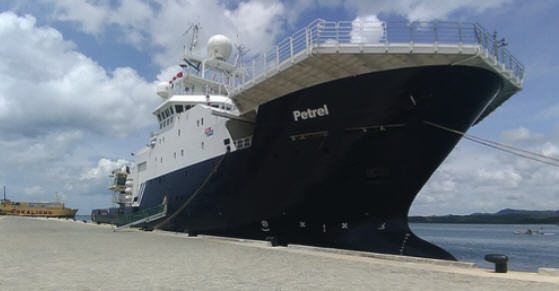
From Sam Cox, Director of the Naval History and Heritage Command:
“Upon arrival on board PETREL, I reacquainted with Mr. Robert Kraft, the head of PETREL’s “A.T.U.” Unit (“All Things Underwater,”) Mr. Paul Mayer, senior researcher and jack of many trades, and Ms. Janet Greenlee, their superb public outreach leader.
Onboard with me were also Mr. Ed Caesar, an award-winning (Foreign Press Association 2014 Journalist of the Year) international correspondent doing a story for the New York Times Magazine, and international award-winning professional photographer David Maurice Smith.
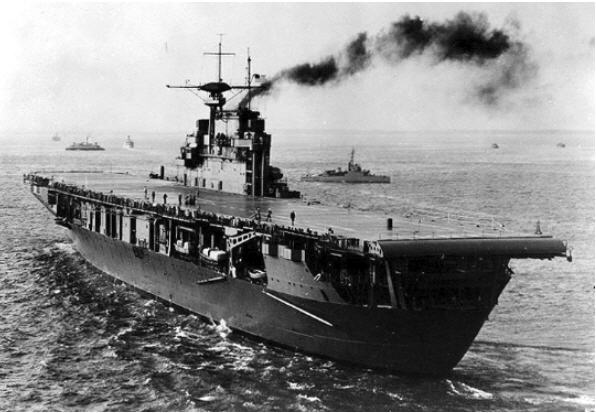
The initial plan was to go after the HORNET first, due to her more extensive battle record (launching the Doolittle Raid on Japan, participating in the pivotal Battle of Midway where her entire torpedo-plane squadron was shot down in one of the most valiant attacks against overwhelming odds in U.S. naval history, and her ultimate loss in the Battle of Santa Cruz in October 1942 where her planes severely damaged the Japanese carrier SHOKAKU and her guns shot down many Japanese aircraft.)
Meteora, the goddess of weather, had other ideas. PETREL had very sophisticated tools for tracking weather and sea states. The Autonomous Underwater Vehicle (AUV) could be launched and operate in almost any weather, but the manned Zodiac boat necessary to retrieve it when it surfaced could not be operated safely in the predicted conditions. The weather in the area of WASP’s sinking was only marginally better, but expected to improve sooner, so Robert Kraft made the decision to go for WASP first (no plan survives contact with the enemy.)
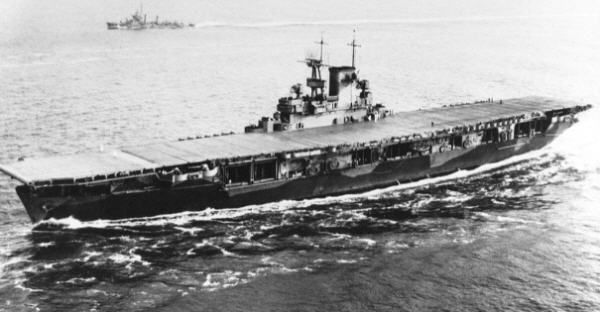
WASP was a one-of-a-kind aircraft carrier, with her tonnage limited by treaty restrictions. She carried about the same number of aircraft (70-80) as the previous YORKTOWN-class (YORKTOWN (CV-5,) ENTERPRISE (CV-6,) and HORNET (CV-8)) but was smaller, with less redundancy and less compartmentation to save weight. She was the first carrier to have a deck-edge elevator. Upon the outbreak of WWII, the less capable WASP was intended to operate in the Atlantic, while the YORKTOWN and HORNET were transferred to the Pacific.
During this period, WASP conducted two aircraft ferry missions, flying off British Spitfire fighters to bolster the defense of beleaguered Malta in the Mediterranean (and recovered one Spitfire (not a carrier aircraft) aboard that had engine trouble after launch, with a few feet to spare.)
However, with the loss of LEXINGTON (CV-2) at Coral Sea and YORKTOWN at Midway, WASP was rushed around to the Pacific.
At the time of the U.S. landings on Guadalcanal on 7 August 1942, WASP provided air support, along with ENTERPRISE, and SARATOGA (CV-3,) while HORNET defended Pearl Harbor from potential Japanese attack.
During the Battle of the Eastern Solomons on 24 August 1942, WASP was out of position, having been ordered to go south to refuel, and missed the battle. ENTERPRISE was badly damaged in the battle and had to return to Pearl Harbor for repairs, and was replaced by HORNET.

On 28 August, SARATOGA was hit by a Japanese submarine torpedo (for the second time in the war) from I-26 and put out of action for several months, leaving WASP and HORNET as the only two operational U.S. aircraft carriers in the Pacific. (I-26 would later sink the light cruiser JUNEAU on 13 November 1942.)
For the first weeks of September 1942, the WASP and HORNET operated south of Guadalcanal, close enough to provide support to the Marines ashore on short notice if necessary, but outside the range of land-based Japanese bombers. The Japanese countered by flooding that operating area with at least nine submarines.
On 15 September Task Force 18, centered on WASP, and TF-17, centered on HORNET, were providing air cover to a convoy transporting the 7thMarine Regiment (about 4,000 Marines) to reinforce the Marines already on Guadalcanal.
At about 1445, just after WASP completed a launch and recovery cycle of aircraft and a particularly vulnerable time, the Japanese submarine I-19 penetrated WASP’s escort screen undetected and fired all six of her bow torpedoes at WASP from the relatively short range of just under 1,000 yards. At least two and possibly three of the torpedoes struck WASP on her starboard side forward, immediately igniting an intense conflagration and causing a 15-degree starboard list.
Among other things, the explosions knocked out the fire mains, so the crew had no effective means to fight the fires that immediately spread.
The U.S. had learned numerous hard lessons in damage-control from the loss of LEXINGTON at Coral Sea (such as filling aviation fuel lines with inert gas) and these lessons had been incorporated and had initially saved YORKTOWN at Midway, despite multiple bomb and torpedo hits, until she was later sunk by a Japanese submarine I-168, and they had saved ENTERPRISE during the Battle of Eastern Solomons.
Unfortunately, many of these preventive measures required warning of an inbound air strike in order to implement. In the case of I-19’s torpedoes, there were only a few seconds of warning.
WASP was quickly rocked by secondary explosions from stored bombs and fuel (and the third torpedo hit may or may not have actually been a secondary explosion.) These were followed by a massive explosion at 1500, and within about 20 minutes it was apparent that saving the ship was impossible and Captain Forrest Sherman gave the order to abandon ship.
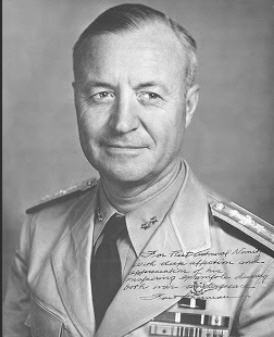
It took about 40 minutes for the crew to abandon the ship and Sherman was the last living person to go into the water. (Sherman would be awarded a Navy Cross and a Purple Heart for his efforts to save his ship.)
Upon the massive explosion on WASP, Rear Admiral Norman Scott, embarked on SAN FRANCISCO, assumed command of TF-18, believing that Rear Admiral Leigh Noyes on WASP would likely have been killed, so violent was the explosion. In fact, Noyes was only burned, but with all radio communication destroyed on WASP, Scott’s decision was correct. (One of the most famous photos of WASP on fire was taken from the SAN FRANCISCO.) Noyes would be relieved of command and criticized, somewhat unfairly, for operating the carriers for too long in the same vicinity, increasing the risk of submarine attack.
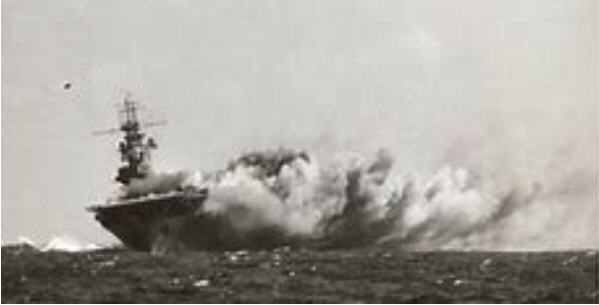
Fortunately, the burning WASP remained afloat for hours, which enabled a relatively orderly abandon ship, and the great majority of WASP’s 2,247-man crew were rescued by WASP’s escorts, including the destroyers LAFFEY (DD-459,) LANDSDOWN (DD-486,) and other destroyers.
Those who were killed included 25 officers, 150 men (which included 4 Marines and 42 aircraft squadron personnel) and one war correspondent, Jack Singer (last seen sitting at his typewriter,) for a total of 176 dead, plus about 175 wounded.
Captain Sherman’s original report filed in December 1942, gave a total of 193 killed (plus the journalist) and that number has been used in almost every account since, although one account (Richard Frank’s very well-researched book, “Guadalcanal”) gave 173 (plus the journalist.) However, very recent research by NHHC historian Bob Cressman confirms 176 (including the journalist;) Frank’s account missed two Marines. This just goes to show there is always something new to learn in history.
Survivors included RADM Noyes, and Captain Sherman, who went on to be the youngest Chief of Naval Operations (CNO) at that time (1949-51,) and unfortunately the youngest to ever die in office, of a heart attack. Benedict Semmes, Jr. went on to serve as a Vice Admiral and President of the Naval War College in the 1970’s. Lieutenant David McCampbell, a Landing Signal Officer (LSO) on WASP, jumped into the water from the LSO platform and went on to be the U.S. Navy’s all-time leading “ace” with 34 Japanese downed aircraft to his credit (a record nine of them in one mission.)

Meanwhile, one of the torpedoes that missed WASP passed directly under LANDSDOWNE (DD-486) without exploding, and LANDSDOWNE radioed a warning as the torpedo headed for the HORNET Task Force. At least three of the torpedoes that missed WASP travelled about five miles into HORNET’s screen, one passing too close to HORNET for comfort. Another passed directly under the destroyer MUSTIN (DD-413) without exploding before hitting the new fast battleship NORTH CAROLINA (BB-55,) killing five Sailors, blowing a 32-by-18 foot hole in the ship, which necessitated the forward ammunition magazine be flooded as a precaution.
Although still capable of making 25 knots, NORTH CAROLINA required extensive repair and was out of action for two months. One of HORNET’s escorting destroyers, the O’BRIEN (DD-415) successfully dodged one of the torpedoes only to be hit in the bow by another. Although no crewmen were killed, the damage was severe enough that O’BRIEN broke apart and sank a month later after transiting over 2,800 miles attempting to reach Pearl Harbor for repair; her entire crew was rescued.
Hitting three ships with at least four of six torpedoes fired in a single spread makes Lieutenant Commander Takakazu Kinashi’s attack arguably the most effective by a submarine of all time. WASP’s escort destroyers dropped 30 depth charges on I-19 but she escaped, only to later be sunk with all hands by destroyer USS RADFORD (DD-446) in November 1943.
For many years, the torpedo hits on NORTH CAROLINA and O’BRIEN were attributed to a second submarine, I-15, however Japanese records confirm I-19 fired all six. I-15 did, however, witness the destroyer LANDSDOWNE as she was ordered to scuttle WASP with a spread of torpedoes at 2100 on 15 September. (Of interest, both I-15 and I-19 were of a class of submarines that were equipped with a hangar and a float plane, and a plane from sister submarine I-25 bombed Oregon twice with incendiary bombs in September 1942, the only air attacks on U.S. soil (lower 48) by foreign aircraft.)
Tomorrow: Iron Bottom Sound
Copyright Sam Cox
www.vicsocotra.com
